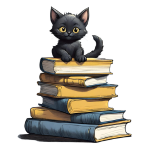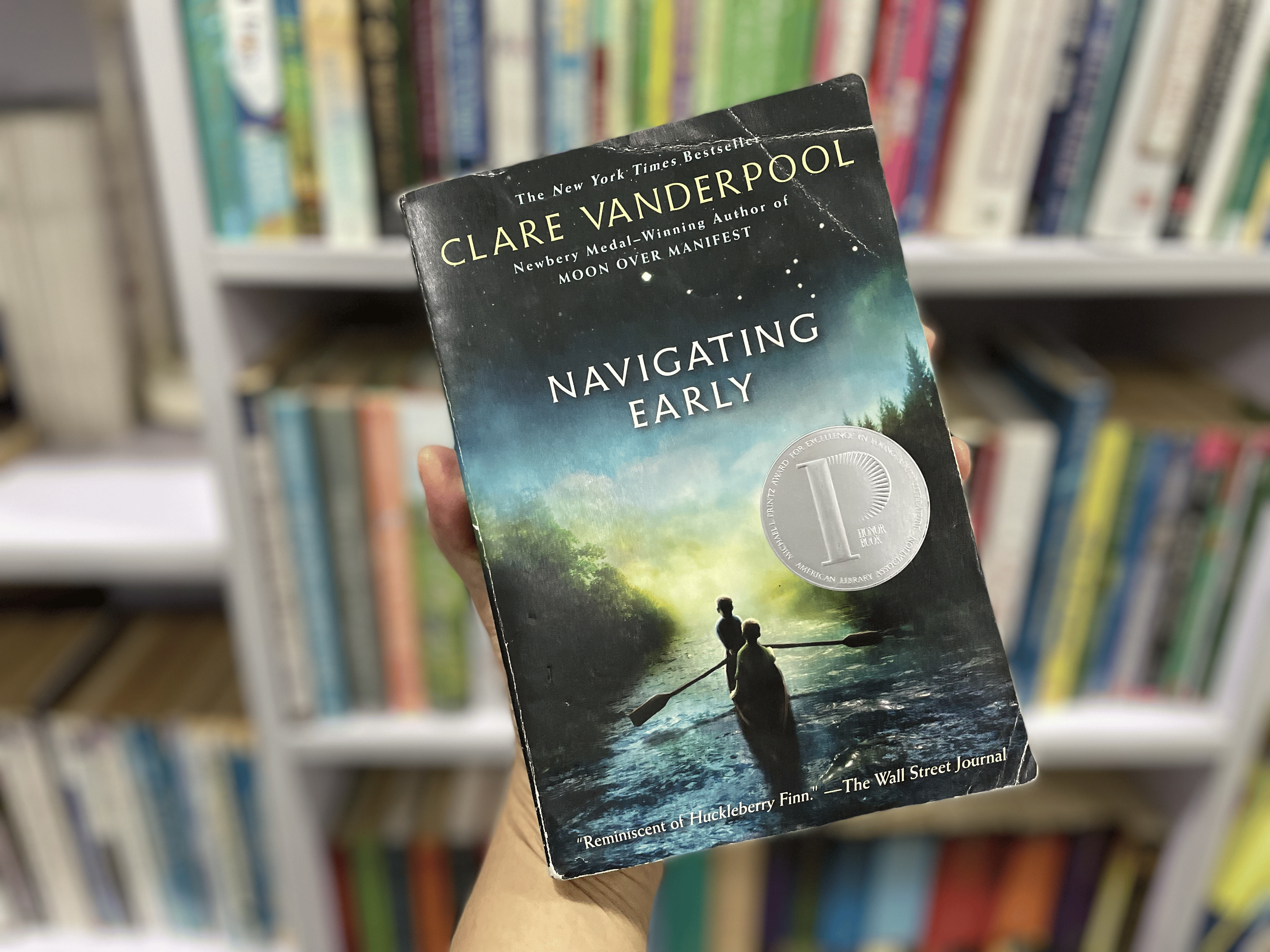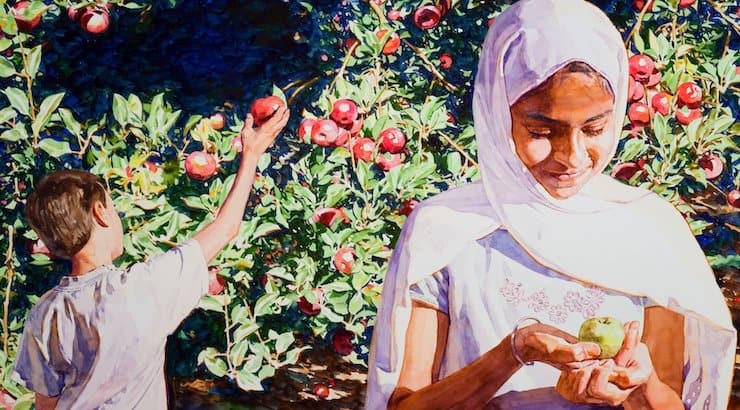“Reading should not be presented to children as a chore, a duty. It should be offered as a gift.”
Kate DiCamillo
Navigating Early
I remember going to the bookstore years ago without a booklist. I didn’t have any title or book in mind, but I knew that I wanted something different… something that would be out-of-this-world good. And boy, did I find a gem in Navigating Early! Clare Vanderpool doesn’t just write… she crafts magically mesmerizing stories that just leave your heart so very full. She won the Newbery Medal for her debut, Moon Over Manifest, but Navigating Early is my favourite.
It is post-World War 2 and we meet Jack, who has been sent to a military boarding school in Maine. He and his father are still stunned from the death of his mother and clearly, neither has grieved properly. Adrift, Jack struggles to fit in and meets Early, a savant, who is an outsider, just like him. The two form a connection for Early also understands loss – his father has recently passed away and his brother, Fisher, is presumed dead from the war.
Early is a strange one – he listens to certain records only on certain days (if it’s raining, it’s always Billie Holiday), is obsessed with the Great Appalachian Bear and the number pi and is convinced that his brother is still alive. Early sees the numbers in pi as a story and it is reminiscent of the legend of Polaris and the Ursa Major constellation. According to Early, Polaris, whose mother calls him by the name “Pi”, wanders and gets lost among the stars. Early believes a similar fate has befallen his brother and resolves to locate him. Since pi is infinite, then Polaris/Fisher cannot possibly be dead.
As Jack and Early go on an odyssey in search of the great black bear, they encounter myriad characters – pirates, a damsel in distress, a bereft old woman waiting for her son, a lonely woodsman who harbours a deep longing and hurt, among others. Early continues to recount Pi’s saga as they journey and reality and fiction parallel each other. Boundaries begin to blur – like Jack, we start out thinking that Early is making up the story as he goes along. However, in a strange and surreal way, it is evident that he is really just retelling what he sees in the numbers.
I won’t say more except this: you have to experience this exquisite puzzle of a book for yourself. This is a story of adventure, friendship, discovery, redemption and transformation. Some have said that Navigating Early is a book that adults love and buy for their children, but that the kids themselves would not want to read. I completely disagree with this. You can see that my copy is now quite battered thanks to my daughter and her friends reading and rereading it.
Yes, you do need to really focus to weave through the different strands, but this book just pulls you in so you have little choice in the matter anyway! You MUST check it out!
Never Enough
“I guess there are never enough books.”
John Steinbeck
“A great book should leave you with many experiences, and slightly exhausted at the end. You live several lives while reading.”
William Styron
One Green Apple
We have our pet authors and Eve Bunting is one of them. We have enjoyed Fly Away Home, The Memory String, Gleam & Glow, Pop’s Bridge, Smoky Night and Whales Passing. One Green Apple is about Farah, a Muslim girl who is new to America. Her headscarf and inability to speak English set her apart from her classmates, some of whom are friendly and some of whom have mentioned her home country in less than friendly terms. Her father has told her, “Our home country and our new one have had difficulties.” We are not told where Farah is from, but I suspect it must be Pakistan or Afghanistan from the word “dupatta” that the author uses for the shawl she wears.
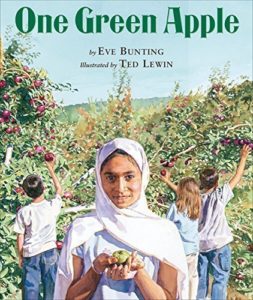 On this day, Farah and her classmates are visiting a farm. She enjoys the sights and smells but is very anxious and feels “tight inside”. When she goes to pick an apple, she chooses a small green one that fits right in her hand. Farah likes it even though the others choose the sweet, red ones … it is different, like her. When they make the cider, her classmates protest as she adds this green apple into the vat of ripe red ones.
On this day, Farah and her classmates are visiting a farm. She enjoys the sights and smells but is very anxious and feels “tight inside”. When she goes to pick an apple, she chooses a small green one that fits right in her hand. Farah likes it even though the others choose the sweet, red ones … it is different, like her. When they make the cider, her classmates protest as she adds this green apple into the vat of ripe red ones.
The barriers begin to break, tentatively, but surely. At first, a friendly girl, Anna, reaches out and then she joins in making apple cider by helping to operate the press. On the way back, she enjoys a lighthearted moment with her new friends. She finally has the courage to say her first “outside myself” word – “App-ell” and her friends applaud her.
Eve Bunting’s subtle storytelling makes this story a joy. What wonderful message – that we really do have a lot in common and that our differences add colour and flavour to the world. I just adore the illustrations – Ted Lewin… need I say more? I cannot gush enough about his winning work! In One Green Apple, his pictures are gloriously sun-drenched and so full of hope! I think many of us can relate to Farah’s fears and awkwardness – I cannot help but beam along with her when she eventually flashes a confident, triumphant smile.
The Roses In My Carpets
This book touched me deeply. A young Afghani’s recurring nightmare pulls us into this story – “It’s always the same. The jets scream overhead.” He dreams of running to escape the bombs together with his mother and sister, Maha. In his dreams, they weigh him down and always, he wakes up to his bare home in a refugee camp.
In quiet and almost grim tones, he tells us about his days. He lives with his mother and sister and they manage to eke out a living with the help of a sponsor. He prays and goes to school, but his most cherished activity is when he learns how to weave carpets. It is his lifeline – he hopes this skill will help provide for his family. It also allows him to visualise and carve out his dreams – a world of hope and beauty. The nameless protagonist uses red threads to honour the martyrs, blue for the sky, free of bombing jets, black for the night that hides them from the enemy and white for the shroud of his father. He uses no browns for he longs to escape the dirty brown huts in the camp.
Then one day, he is confronted with the possibility losing yet another member of his family… Will this make him or break him? Has his well of hope run dry?
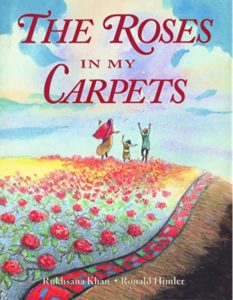 I personally love this book – Ronald Himmler’s illustrations are always beautiful and in this case, he has sensitively captured the grief and quiet dignity of the family. [You might recognize his work in Sadako and the Thousand Paper Cranes, Rudy’s Pond, Fly Away Home and The Well.] The contrast between the muddy walls and vibrant carpets bring home the themes of strife and hope.
I personally love this book – Ronald Himmler’s illustrations are always beautiful and in this case, he has sensitively captured the grief and quiet dignity of the family. [You might recognize his work in Sadako and the Thousand Paper Cranes, Rudy’s Pond, Fly Away Home and The Well.] The contrast between the muddy walls and vibrant carpets bring home the themes of strife and hope.
I think it was brave of Rukhsana Khan to write a story about the very painful ramifications of war. Death, displacement, poverty and trauma don’t make for happy reading, but The Roses in My Carpet is masterfully told. Some may say that this book is too distressing for children, but I feel it is important that my children, who have been blessed with safety and stability, understand the agony that other children from war-torn countries have endured. Their feelings and well-being matter just as much.
The story ends on a hopeful note – the boy dreams again, but this time, his family finds a space away from the bombs, where the earth is strewn with red roses and where the sky is blue and free from the menacing jets.
The Salamander Room
I found The Salamander Room by Anne Mazer in a second-hand bookstore here in Islamabad and it is SUCH a treasure. This is a story about little Brian who finds a salamander and wants to keep it in his room. What follows is a series of gentle questioning from his mum – it’s really sweet that she doesn’t say “Euww! No way!”
She asks how he will cater to the creature’s needs – “Where will he sleep?” etc. Brian answers all of her questions and concerns with imaginative solutions:
- make a bed for the salamander with leaves and moss
- bring in crickets and bull frogs to lull it to sleep
- collect wet leaves, stumps and boulders for the salamander’s play
- bring in other salamanders for company
- make a pool and bring in insects for the salamander’s food and drink
- control the insect population by bringing in birds and bullfrogs
- provide trees and ponds for the birds and bullfrogs
- lift off his room’s ceiling so the sun can shine through, trees can grow and so the birds can fly freely
I love how Steven Johnson’s illustrations chart Brian’s grand dreams. As the story progresses with each addition, this creative child’s bedroom is transformed into a lush jungle paradise!
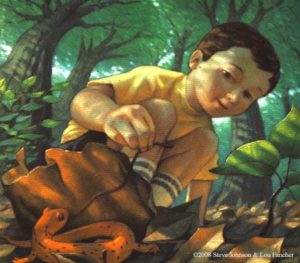 The Salamander Room is a wonderful example of how a living book can be a springboard to nature studies and science. Your little one will be introduced to topics like cause and effect, habitats, amphibians, rainforests, ecology and how we can do our bit to care for the environment.
The Salamander Room is a wonderful example of how a living book can be a springboard to nature studies and science. Your little one will be introduced to topics like cause and effect, habitats, amphibians, rainforests, ecology and how we can do our bit to care for the environment.
Some activities you can do with your kids:
- Check out Five in a Row for a great learning adventure.
- Reading Rainbow has very nice free educational guides for this book.
- Homeschool Share has a salamander lapbook.
- Mama’s Learning Corner has a literature-based unit study on this book.
- As We Walk Along the Road has a very detailed unit study guide about salamanders … this is part of her awesome free ebook The Ultimate Book of Unit Studies for Literature Lovers.
This review was first published on Imaan.Net in August 2005 and has been updated for this site.
Salamander image by @issa_user via Twenty20
The Day of Ahmed’s Secret
Back in 2009, my friend Suzanne, who teaches English (among other things!) met with me and our conversation invariably meandered to books. She just about gushed over The Day of Ahmed’s Secret written by the late Florence Parry Heide and her daughter, Judith Heide Gilliland. Of course, I needed very little encouragement to hunt the book down!
Before I talk about this book, I MUST talk about the illustrator, who is one of my favourites – Ted Lewin. I can’t draw or paint for toffee, but I have always longed for the ability because of amazingly talented artists like him. Ted Lewin has illustrated numerous books that my kids and I enjoy. He has an inimitable style that gives the stories warmth and life. His watercolours are remarkably detailed and in this book, he and the authors expertly capture the sights, smells and sounds of the markets and busy streets of Cairo.
Every single time I read a book he has illustrated, I feel as if I were looking at a photograph! I’ve discovered the secret to his realistic and vibrant pictures – he uses his friends and neighbours and their kids as subjects and directs them to ‘act’ out the story while he photographs them in the studio!
The Day of Ahmed’s Secret is about young Ahmed who rides through the streets of Cairo to deliver cylinders of butane gas (it is for cooking) to his father’s customers. He has a secret to tell his family, but it must keep till the evening for he has his job to do first. Ahmed seems rather young for such hard work (he looks no more than 10 or 11), but he does it patiently (there is not a hint of complaint from him) and quite obviously, out of a sense of love and duty for his family. We sense how mature he is in his quiet introspective nature and in how he understands why he has to grow up quickly to help ease his father’s burden.
As Ahmed weaves in and out of the city, we meet various characters – the food vendor who always has a word for him, the rose water man, the customers and all the folks who make up the hustle and bustle of Cairo that he is a part of. He reflects on how old the city is and talks of the desert in almost sentimental terms. Through it all, we are constantly reminded of the secret he is carrying.
I could talk about all kinds of learning points like Egypt, deserts, pyramids and what not, but I prefer to just bask in the gorgeousness of this book 🙂
When Ahmed finally returns to the warmth and comfort of home, he finally divulges his surprise. It is worth the wait – I was so proud of him and felt like thumping his back!
A keeper!
Fields of Home
Fields of Home by Marita Conlon-McKenna is the third and final volume of the Children of the Famine trilogy. (I have reviewed the first two books, Under the Hawthorn Tree and Wildflower Girl.)
It has been twelve years since the Famine struck Ireland and the O’Driscoll siblings are now young adults and are still trying to build better lives. Eily and her husband have two children and are living on a farm with her great aunt, Nano. Michael is happily working in the stables in the Great House and is even riding in races. Peggy (I have such a spot for this lovely girl!) is still struggling to find her place and dreams in a land that hasn’t quite embraced her.
Ireland is in turmoil – rents are escalating for tenant farmers like Eily and her neighbours and the threat of eviction is ever looming. We see much of this through the eyes of Mary Brigid, Eily’s daughter – landlords are heartlessly throwing tenants out of the only homes they have ever known and like Mary Brigid, we worry and wonder where they will go and how they will manage. Michael, in training to be a horseman, loves his work, but his happiness is short-lived. He finds himself on his own again when the property where he works is sold following a fire. He has no place to go except back to Eily’s farm. The O’Driscolls must now rely on their ingenuity if they are to survive in post-famine Ireland.
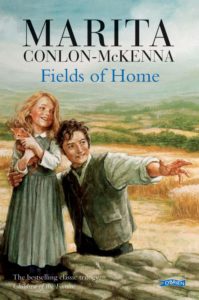 Peggy, meanwhile in Boston, is acutely lonely – she is trapped in drudgery and her two friends are moving on. Kitty, her fellow maid, has moved on to serve in another house and Sarah, her beloved friend is moving West to better her health and prospects. James, Sarah’s brother, proposes to Peggy and asks her to come along. Despite her dire circumstances, Peggy is unwilling to settle and wants a true soul mate.
Peggy, meanwhile in Boston, is acutely lonely – she is trapped in drudgery and her two friends are moving on. Kitty, her fellow maid, has moved on to serve in another house and Sarah, her beloved friend is moving West to better her health and prospects. James, Sarah’s brother, proposes to Peggy and asks her to come along. Despite her dire circumstances, Peggy is unwilling to settle and wants a true soul mate.
You will find yourself rooting for these brave siblings. They are a tough lot – the kind who just grit their teeth and roll up their sleeves no matter what life throws at them. They are confronted with heartbreak and struggle at every turn and yet, even when they have barely anything to give, they reach out and help one another. This is what I found most heartwarming about this story – their undeniably strong love and their abundant hope.
This book may be for slightly older readers simply because the characters deal with more adult issues like politics, employment and marriage. My girls and I enjoyed the journey with the O’Driscolls and we formed such an attachment to the characters. This story ends on a beautiful note – there is finally the promise of better times!
Wildflower Girl
Wildflower Girl by Marita Conlon-McKenna is the sequel to Under the Hawthorne Tree. (You can read my review here.) This book sees Eily, Michael and Peggy alive and well six years later in Castletaggart. Aunt Lena is now dead and the girls and Aunt Nano try to eke out a living at the bake shop. However, times are hard – many inhabitants of Castletaggart have either died in the Great Famine or have left.
Aunt Lena’s landlord decides to sell his property and move to Dublin. This essentially means that the family will be all but homeless, and it was indeed a bleak time in their village and Ireland. The landlord offers to pay for the family to go to America and this seems to offer some hope for a new start. However, Nano is too old to travel; Eily accepts a marriage proposal and Michael gets a job in a stable. Young Peggy, all of thirteen, decides to take her chances and migrate for a better life. What else is left for her otherwise?
As the family prepares for the impending separation, the grief is poignantly described. You can’t help but think of the larger picture as well – the mass exodus saw the population of Ireland drop by some twenty-five percent. One million people died of starvation or disease and another million emigrated. I read elsewhere that the famine contributed to the decline in the use of Gaelic as well – West Ireland, where Gaelic was at its strongest, was also the hardest hit in terms of deaths and emigration.
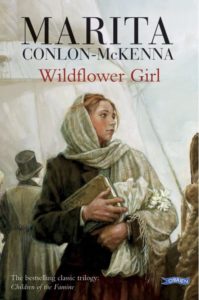 Peggy braves horrifying conditions on the month-long journey across the Atlantic. The poor passengers endure sea-sickness, cabin fever and wretchedly awful meals. Peggy survives this ordeal with the help of a friend, Sarah.
Peggy braves horrifying conditions on the month-long journey across the Atlantic. The poor passengers endure sea-sickness, cabin fever and wretchedly awful meals. Peggy survives this ordeal with the help of a friend, Sarah.
Life isn’t much easier in the promised land – the new immigrants are looked down upon and frequently taken advantage of. Peggy gets a job in a lodging house but is abused by the drunken proprietor. As a maid later in a large house, she toils endlessly and is not even given facilities for a bath. Joy for the homesick Peggy is visiting Sarah on her days off and sitting amongst the wildflowers that remind her of home.
I really enjoyed this second instalment of the Children of the Famine series. My daughters were truly moved by the courage of Peggy who left home for a strange land at such a young age. It was such a different time then… a time when children had to grow up fast and hard. We were hooked and looked forward to final book in the series.
Do check out my review of Fields of Home.
